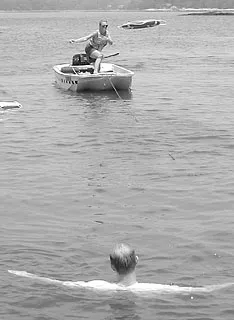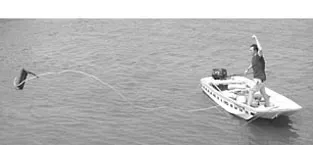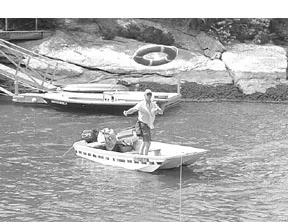This spring and summer there were a number of well-publicized incidents of people falling off boats and having to be recovered by the crew. In almost all these cases, the MOBs were professional sailors aboard racing sailboats. One died, and was almost certainly unconscious from a traumatic blow when he hit the water. The others, who went swimming mid-ocean in rough conditions, were extremely lucky to have gone overboard in daylight, and to have been parts of competent crews.

There are always plenty of these incidents, and not all of them end happily. In almost every case, there are lessons learned. Nothing goes as planned. Luck, both good and bad, intervenes.
It’s not our purpose here to try to cover the whole subject of man-overboard emergencies, or to quote from the many studies that have been done on the topic. We’d just like to offer the following reminders:
If someone goes over the transom unnoticed when the boat is moving at 6 knots, he or she will be a football field away in 30 seconds. Let’s hope they’re wearing a PFD. Meanwhile, assuming someone did notice them go overboard, the full crew now has a big project on their hands. The situation is immediately fraught with a number of dangers—injury, panic, spinning propeller, plunging hull, darkness or limited visibility, rough conditions, and any combination thereof. Then, assuming you can locate the person right away, you have the problem of keeping them in sight, reaching them, and establishing some sort of physical contact with them. Finally, you face the very serious problem of getting them back on boat, in whatever state they’re in.
For this evaluation we decided to tackle the middle set of problems—establishing physical contact with the MOB—simply by trying out the gear that’s meant to apply: Type IV Throwable Devices, as required by the Coast Guard. We didn’t include the Lifesling or launchable man-overboard modules in this evaluation; neither of these are throwable devices per se, and in any case the purposes and capabilities of the Lifesling are well-known. As a system for recovering people unable to come up a ladder or onto a swim platform, it’s probably the best MOB recovery gear available for sailors.
We settled on two simple criteria for our evaluation: First, how easily and accurately do these throwable devices actually throw? Second, how do they perform once the MOB has them in hand?
What We Tested
We last tested Type IV throwables back in 1993. Since then, the basic products available to boaters (cushions, rings and horseshoes) have remained much the same. For this evaluation, though, we included a prototype device brought to our attention by Dan McCormick, of the US Coast Guard’s Lifesaving and Fire Safety Standards Division, who we called for a sanity check on our test procedures. Mr. McCormick suggested we check out a new cushion developed by two California powerboaters, Don Anderson and Jim Way. It’s called the Lifeline P.F.D. It looks like a standard boat cushion but has a Velcro-closed pouch on one side that stores 42 feet of polypropylene line. The cushion end is spliced into a loop of webbing, heavily sewn on both ends inside the cushion. The far end also has a spliced loop for the tosser to hold.
The Lifeline has already received USCG approval, and UL (Underwriters Laboratories) approval is expected before the end of the year, which means the product should be available early in 2003.
We also tested throwable cushions from Kent and Stearns.
Our rings (24″ and 30″) were both made by Jim-Buoy. (The company also makes a 20-incher.) Horseshoe rings from Jim-Buoy and Forespar rounded out our Type IV test group.
Finally, we tried three throw-rope bags—70-footers from Sospenders and Forespar, and a 50-footer from West Marine.
How We Tested
We set up a “test range” consisting of an old Boston Whaler (our throwing platform) anchored by the stern. At the bow we cleated one end of a 50-foot red floating line. We stretched that line dead to windward and put the bitter end through a fender with a knot. Then we anchored the fender. This gave us a windward range, and luckily the wind blew at a steady 12-15 knots for most of the test time. After several people threw everything several times, we reoriented the 50-foot line across the wind by tying it to a dock.
The test tossers (three men and a woman) threw everything according to the directions, and also a few times according to our own sense of how to do things. We can report right here that we never did better with our own methods than with the directions, although sometimes we came out about even, as with the football toss of the rope bags. So we might as well follow the directions.
There are differences between tossing cushions and lines from an open Boston Whaler and from the deck of a sailboat, as anyone who has tried it will recognize. The added few feet of height will give a big advantage in how far the object can be tossed; however, that advantage can be erased instantly if you hit or get tangled up with any of the obstacles that infest the aft end of a sailboat—notably the backstay, but also the mainsheet, runner tails, antennas, lifelines, and the stern pulpit and anything mounted on it.
Results
In the Air: The hands-down winner of the distance toss was the white Jim-Buoy life ring. It has the best combination of weight and aerodynamic ability, and flew well when tossed with a backhand throw, more or less like a Frisbee. Two of the tosses took it to about 40′, directly upwind with decent accuracy, and two of the cross-wind tosses took it to about 60′ with decent accuracy.

The orange Jim-Buoy life ring was also good at flying, but it was just too hefty to make it as far. The best toss for that was about 35′, with decent accuracy. Most tosses were in the 25′ range.
The Jim-Buoy and Forespar horseshoes both tossed surprisingly well, although technique varied. Some throws were backhands, some were discus-style. The best tosses seemed to be with a grip on the fastened cross-strap, but in an emergency situation that strap would probably be undone after the horseshoe came out of its bracket.
The Jim-Buoy horseshoe is a bit larger than the Forespar, and filled with hard Styrofoam. The Forespar is filled with a softer foam. There was some debate about which tossed easier, but they performed about the same. Most tosses were in the 40′ range upwind, and slightly better cross-wind, with decent accuracy.
The three throw-rope bags also performed similarly, although there are some differences to report: The Sospenders and West Marine products we tried are nearly identical—same line, same bag construction and color, same closure hardware, same plastic tube enclosing the grab loop on the MOB end. An e-mail to West Marine confirmed that Sospenders makes West Marine’s product, although West Marine’s Chuck Hawley says that West is changing the bags to a day-glow green color and adding reflective tape. Forespar uses a slightly larger, more water-resistant bag, filled with 70 feet of thicker, heavier floating line. While the Sospenders and West lines have the plastic-handled loops for the MOB, the Forespar has a simple knot.
Our best tosser was able to achieve remarkable accuracy with the bags, eventually putting all three nearly on top of the 50′ marker with consecutive tosses (both underhand, as per the instructions, and overhand, as per Joe Montana). Performance being about equal, he preferred the West and Sospenders products simply because they were smaller, lighter, and easier to handle. In pulling a MOB forcefully to the boat, we found the simple Forespar knot less desirable than the plastic-covered grab loops.
Note that these throw-ropes should always be stowed in their bags flaked, not coiled. In the first case, they run out freely. In the second they’re prone to snarls.
Finally, in the cushion competition, we weren’t very surprised to confirm that these suckers just plain don’t fly, either upwind or cross-wind. In fact, in some of the early upwind throws we were lucky not to have them land behind the tossing point. They toss better downwind, of course, but don’t have enough mass to stay aloft for long, and it was hard not to throw them wild.
We found that the softness or rigidity of the cushions made a big difference in how they tossed. The Stearns cushion was too light and squishy. The Kent was somewhat better. In fact, these two are almost identical; the main difference is that the Stearns cover is looser-fitting. But that has a big effect—it makes the whole thing floppier, less throwable and less supportive in the water.
The best was the Lifeline. It was the most rigid of the three, and flew farthest, even with its line attached. In fact, it had a couple of fairly decent flights, and might have even traveled farther than its 42′ line permitted it. We were surprised to see the thin polypropylene pay out as well as it did; we never encountered any significant snarls.
In the Water: Swimmers tried both rings, both horseshoes, and all the cushions on for size in the water. While all Type IV devices are intended for use in quick recoveries, things don’t always work out that way, and often MOBs are in the water for a long time. We tried to imagine which devices would make us feel most secure if we had to float by ourselves for a matter of hours in rough or dark water. Logic suggests that the big orange Jim-Buoy ring would walk away with that award—it had the greatest buoyancy of all the devices. However, it was actually too big to offer a close fit, and a close fit in these matters is a good thing. The white Forespar ring, the Jim-Buoy horseshoe, and the Forespar horseshoe were better at offering a sense of security in that regard. Among those, it was tougher to choose.

The tricky part was figuring out the best ways to hang on to the things. You’re not supposed to wear them, just hold them—but of course most people will try to wear them somehow anyway. A medium-sized man can fit through the hole in the Forespar ring, but a man bigger than about size 40 will have a tough time. That leaves what—a head and one arm? Or lying across the ring, forearms folded? The horseshoes offer more options—lying backwards in the curve, lying forwards in the curve, lying on top with arms folded across, etc. One swimmer even found it comfortable to lie backwards in the curve with both knees supported against the buckled strap.
Suggestion to the Type IV device makers: Put a diagram or two on the device itself, suggesting a few likely positions. The Kama Sutra of MOB.
Among the cushions, the winner again was the new Lifeline. Being stiffer, it was easier to maneuver in the water, yet it was still flexible enough to conform to the curve of the swimmer’s body, offering steadier support. Its self-draining pouch also retained some water after each toss, which had the effect of slowing its speed across the surface in the wind, and making it act like a mini-drogue.
A single boat cushion will certainly not offer much of a sense of security to a MOB in the water for hours, although, as one tester put it, “It’s a lot better than a big rock.”
Conclusions
The ratings in the chart on pages 9-10 will speak for themselves. Of the two rings, we prefer the smaller Jim-Buoy unit. Between the horseshoes, it’s a toss-up. The Forespar is very nicely built and slightly easier to work with; the Jim-Buoy has a more utilitarian look and greater buoyancy. They performed about the same in the toss testing and in the water with the swimmers. If forced to give a nod, we’d give it to the Jim-Buoy because of the buoyancy, and because it costs less.
As for the throw-ropes, another toss-up. We’d lean toward West or Sospenders, for reasons already stated. BoatU.S. is currently selling the Sospenders bags for less than West Marine is selling the same bags under its own name. Meanwhile SailNet is offering the 70′ Forespar bag for only $33. Check all websites for the latest.
Among the cushions there’s a clear winner, at least if you intend to rely on a cushion as Type IV device: the Lifeline cushion. As one tester said, “It doesn’t do anything really well, but it does everything pretty well. If I had to pick only one of all these things, I’d pick that.”
For sailors, a winning combination would be either of the horseshoes and the Lifeline cushion, although we can discover no reason, other than recent tradition, that a ring can’t be mounted on a bracket on a sailboat’s stern pulpit. If you want to go round, go round.
Read the sidebar above, and remember, it’s all worth practicing.
Also With This Article
Click here to view “Value Guide: Type IV PFDs & Throw Ropes.”
Click here to view “Throwable Device (Type IV PFD).”
Click here to view “MOB Emergency Moves.”
Contacts – BoatU.S., 800/395-2628, www.boatus.com. Cal-June JimBuoy, 818/761-3516, www.jimbuoy.com. Kent Sporting Goods, 433 Park Ave., New London, OH, 44851, 419/929-7021. Lifeline PFDs, 714/893-1920, www.lifeline-pfd.com. Forespar Products, 949/858-8820, www.forespar.com. Sospenders, 208/452-5780, www.sospenders.com. Stearns, 800/697 5801, www.stearnsinc.com. West Marine, 800/BOATING, www.westmarine.com.



































